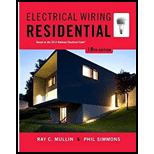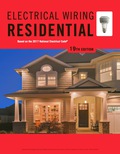
Electrical Wiring: Residental - With Plans (Paperback) Package
18th Edition
ISBN: 9781305416376
Author: MULLIN
Publisher: Cengage
expand_more
expand_more
format_list_bulleted
Question
Chapter 25.3, Problem 20R
To determine
Whether the low-voltage bell wire can also be pulled in the same holes in studs and joists that consist of non-metallic-sheathed cable.
Expert Solution & Answer
Want to see the full answer?
Check out a sample textbook solution
Students have asked these similar questions
Q3/A unity-feedback system with the forward transfer function
S(S+7)
is operating with a closed-loop step response that has 15% overshoot. Do the
following:
a. Evaluate the settling time.
b. Design a PD compensator to decrease the settling time by three times.
K
Q2/ Consider the system G(S)
H(S)=1.5 0.4923.
S(S+1)(S+2)
a. Evaluate the steady-state error for a unit ramp input.
b. Design a lag compensator to improve the steady-state error by a factor of
10(increase the static velocity error constant Kv to about 10 times) to get a new
dominant closed-loop poles. s=-0.3± j0.55. place the zero of the lag compensator
at s=-0.05
c. if R1= 10K, R2=5K2, R3= 10K2 design the lag compensator using Op amp
If the switch in Fig. 4 has been open for a long time and is closed at t = 0,
find vo(t).
t=0
292
ww
+
ΔΩ
3F=
Vo
12 V
Chapter 25 Solutions
Electrical Wiring: Residental - With Plans (Paperback) Package
Ch. 25.1 - How many television outlets are installed in this...Ch. 25.1 - Which type of television cable is commonly used...Ch. 25.1 - What determines the design of the faceplates used?...Ch. 25.1 - Prob. 4RCh. 25.1 - From a cost standpoint, which system is more...Ch. 25.1 - Prob. 6RCh. 25.1 - Prob. 7RCh. 25.1 - Prob. 8RCh. 25.1 - Which article of the Code references the...Ch. 25.1 - It is generally understood that grounding and...
Ch. 25.1 - Prob. 11RCh. 25.1 - Prob. 12RCh. 25.1 - Which section of the Code prohibits supporting...Ch. 25.1 - When hooking up one CATV cable and another cable...Ch. 25.1 - Prob. 15RCh. 25.1 - Prob. 16RCh. 25.2 - How many locations are provided for telephones in...Ch. 25.2 - At what height are the telephone outlets in this...Ch. 25.2 - Sketch the symbol for a telephone outlet.Ch. 25.2 - Is the telephone system regulated by the NEC?...Ch. 25.2 - a. Who is to furnish the outlet boxes required at...Ch. 25.2 - Who is to furnish the telephones? _____Ch. 25.2 - Who does the actual installation of the telephone...Ch. 25.2 - How are the telephone cables concealed in this...Ch. 25.2 - Prob. 9RCh. 25.2 - What are the colors contained in a four-conductor...Ch. 25.2 - Itemize the code rule for the installation of...Ch. 25.2 - If finger contact were made between the red...Ch. 25.2 - What section of the Code prohibits supporting...Ch. 25.2 - The term cross-talk is used to define the hearing...Ch. 25.2 - Which section of the Code prohibits telephone...Ch. 25.3 - Prob. 1RCh. 25.3 - What style of chime is used in this residence?...Ch. 25.3 - a. How many solenoids are contained in a 2-tone...Ch. 25.3 - Explain briefly how two notes are sounded by...Ch. 25.3 - a. Sketch the symbol for a push button....Ch. 25.3 - Prob. 6RCh. 25.3 - What is the maximum volt-ampere rating of...Ch. 25.3 - What two types of chime transformers for Class 2...Ch. 25.3 - Is the extension chime connected with the front...Ch. 25.3 - a. What change in equipment may be necessary when...Ch. 25.3 - What type of insulation is usually found on...Ch. 25.3 - Prob. 13RCh. 25.3 - a. How many wires are run between the front hall...Ch. 25.3 - Why is it recommended that the low-voltage...Ch. 25.3 - a. Is it permissible to install low-voltage Class...Ch. 25.3 - a. Where is the transformer in the residence...Ch. 25.3 - a. How many feet of 2-conductor bell wire cable...Ch. 25.3 - Prob. 19RCh. 25.3 - Prob. 20RCh. 25.3 - What section of the Code prohibits supporting fire...Ch. 25.3 - Prob. 22RCh. 25.3 - What does the term Wi-Fi stand for? _____Ch. 25.3 - A Wi-Fi system is (required) (optional). (Circle...
Knowledge Booster
Similar questions
- A 3-phase, 50 Hz, 132 kV overhead line transpose system of bundle conductors .a radius of conductor is 0.5 cm. Calculate the total inductance of the line. 4m bi cl 4m Am biarrow_forwardControl limits are to be established based on the average number inspected from the information in Exercise 8. What are these control limits and the central line? Describe the cases where individual control limits will need to be calculated.arrow_forwardCan you show why the answer is 3.55Aarrow_forward
- Don't use ai to answer I will report you answerarrow_forwardCorrelation of experimental data for the average heat transfer coefficient for turbulent flow through tubes is given by NUD =hD/k=0.023 (Rep) 0.8 (Pr) 1/3 The Reynolds number, Re₁ = πD/v, is based on the tube diameter D, the average flow velocity ū and the kinematic viscosity v. Consider the flow of air and of water through tubes of identical size. Assume that the average velocity is the same for both fluids. If the average temperature for both fluids is 80°C, determine the ratio of the heat transfer coefficient of water to that of air.arrow_forwardDon't use ai to answer I will report you answerarrow_forward
arrow_back_ios
SEE MORE QUESTIONS
arrow_forward_ios
Recommended textbooks for you
 EBK ELECTRICAL WIRING RESIDENTIALElectrical EngineeringISBN:9781337516549Author:SimmonsPublisher:CENGAGE LEARNING - CONSIGNMENT
EBK ELECTRICAL WIRING RESIDENTIALElectrical EngineeringISBN:9781337516549Author:SimmonsPublisher:CENGAGE LEARNING - CONSIGNMENT

EBK ELECTRICAL WIRING RESIDENTIAL
Electrical Engineering
ISBN:9781337516549
Author:Simmons
Publisher:CENGAGE LEARNING - CONSIGNMENT